传感器的原理及其应用解读
传感器的工作原理及应用场景
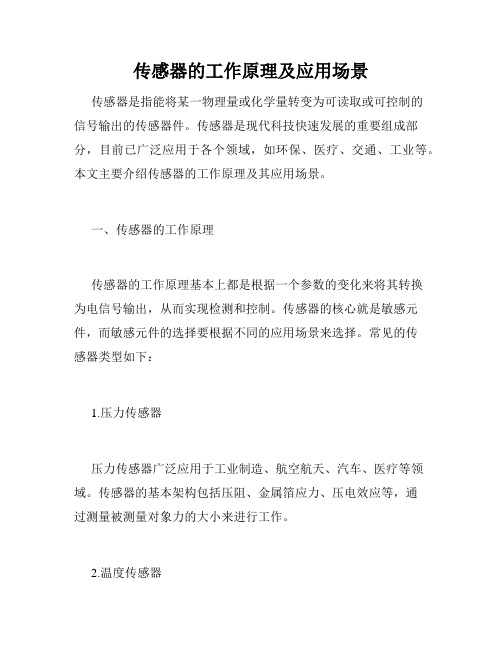
传感器的工作原理及应用场景传感器是指能将某一物理量或化学量转变为可读取或可控制的信号输出的传感器件。
传感器是现代科技快速发展的重要组成部分,目前已广泛应用于各个领域,如环保、医疗、交通、工业等。
本文主要介绍传感器的工作原理及其应用场景。
一、传感器的工作原理传感器的工作原理基本上都是根据一个参数的变化来将其转换为电信号输出,从而实现检测和控制。
传感器的核心就是敏感元件,而敏感元件的选择要根据不同的应用场景来选择。
常见的传感器类型如下:1.压力传感器压力传感器广泛应用于工业制造、航空航天、汽车、医疗等领域。
传感器的基本架构包括压阻、金属箔应力、压电效应等,通过测量被测量对象力的大小来进行工作。
2.温度传感器温度传感器主要分为接触式和非接触式两类。
接触式温度传感器使用热电偶、热电阻等方式来感知温度变化;而非接触式温度传感器则可以使用红外线或激光来探测之前的物体表面温度,并通过计算来得到其温度。
3.光学传感器光学传感器一般采用光电或光阻效应,用于检测环境光线的变化。
常见的应用场景包括测量胶印等工业制造、光学测距、光学编码器和自动化控制。
4.气体传感器气体传感器可以感知环境中不同气体的浓度变化,常用于工业污染源检测、室内空气质量检测等领域。
同样,该类型的传感器也有接触式和非接触式之分。
二、传感器的应用场景传感器被广泛应用于各个领域,下面列举几个常见的应用场景:1.工业制造传感器在工业制造中发挥着重要作用,如生产线中的检测、自动化控制等。
例如,在润滑油的添加过程中,可使用嵌入式压力传感器检测液压油的泵入工况,在正确泵入的同时避免加油过多或过少。
2.环境监测传感器在环境监测中也是非常重要的。
例如,在城市交通中可运用悬挂式磁场强度传感器来监测车辆的行驶轨迹,以及酷暑天气下的车辆散热情况。
3.医疗行业传感器在医疗行业中的应用也是越来越普遍,如心源性猝死的预警装置、体征监测装置、有限空间下的呼吸氧浓度检测等。
它们可以很好地提高医疗设备的效率,提供更好的诊断结果。
光学传感器的工作原理及其应用
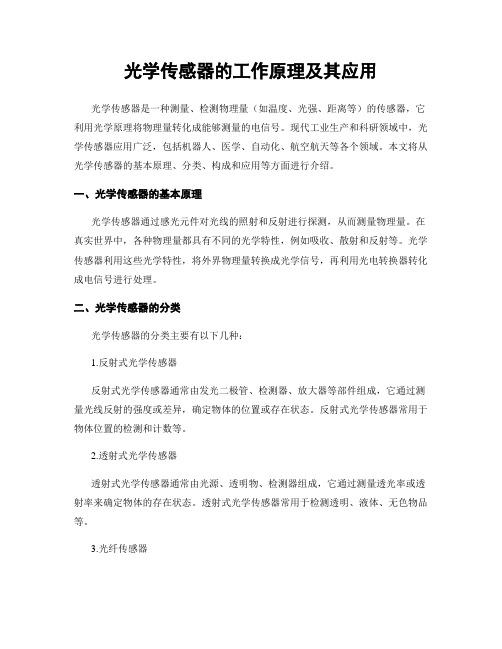
光学传感器的工作原理及其应用光学传感器是一种测量、检测物理量(如温度、光强、距离等)的传感器,它利用光学原理将物理量转化成能够测量的电信号。
现代工业生产和科研领域中,光学传感器应用广泛,包括机器人、医学、自动化、航空航天等各个领域。
本文将从光学传感器的基本原理、分类、构成和应用等方面进行介绍。
一、光学传感器的基本原理光学传感器通过感光元件对光线的照射和反射进行探测,从而测量物理量。
在真实世界中,各种物理量都具有不同的光学特性,例如吸收、散射和反射等。
光学传感器利用这些光学特性,将外界物理量转换成光学信号,再利用光电转换器转化成电信号进行处理。
二、光学传感器的分类光学传感器的分类主要有以下几种:1.反射式光学传感器反射式光学传感器通常由发光二极管、检测器、放大器等部件组成,它通过测量光线反射的强度或差异,确定物体的位置或存在状态。
反射式光学传感器常用于物体位置的检测和计数等。
2.透射式光学传感器透射式光学传感器通常由光源、透明物、检测器组成,它通过测量透光率或透射率来确定物体的存在状态。
透射式光学传感器常用于检测透明、液体、无色物品等。
3.光纤传感器光纤传感器主要是一种光学能量传输和监测技术,它是利用光纤的折射和反射等特性对环境参数进行测量。
光纤传感器可以利用其精密的测量性能、抗干扰性能和温度补偿等优点,广泛应用于环境监测、军事、油气等领域。
三、光学传感器的构成要素光学传感器主要由光源、光纤、检测器、信号处理器和输出等几个部分组成。
其中,光源和光纤负责光信号的传递,检测器将光信号通过光电转换器转化为电信号,信号处理器对电信号进行解析和去噪等处理,输出部分将结果输出到人机界面等终端上,提供给用户参考。
四、光学传感器的应用光学传感器在工业、医学、军事、石油等领域具有广泛的应用,下面主要介绍其应用领域如下:1.机器人领域机器人在工业生产和制造等领域中不断发展和应用,光学传感器在机器人领域中可以扮演非常重要的角色。
传感器原理与应用
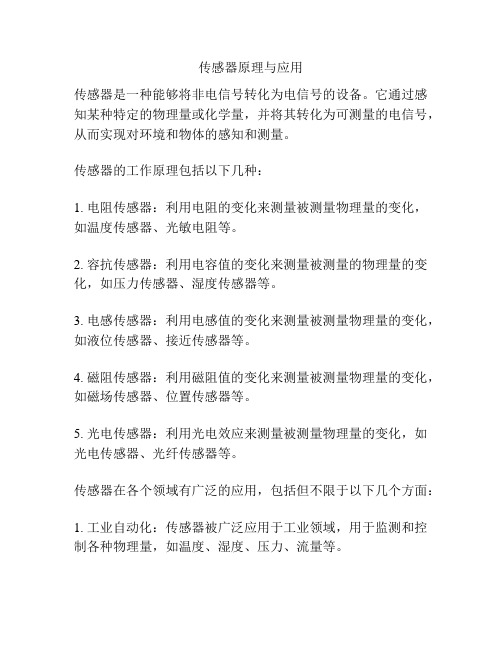
传感器原理与应用
传感器是一种能够将非电信号转化为电信号的设备。
它通过感知某种特定的物理量或化学量,并将其转化为可测量的电信号,从而实现对环境和物体的感知和测量。
传感器的工作原理包括以下几种:
1. 电阻传感器:利用电阻的变化来测量被测量物理量的变化,如温度传感器、光敏电阻等。
2. 容抗传感器:利用电容值的变化来测量被测量的物理量的变化,如压力传感器、湿度传感器等。
3. 电感传感器:利用电感值的变化来测量被测量物理量的变化,如液位传感器、接近传感器等。
4. 磁阻传感器:利用磁阻值的变化来测量被测量物理量的变化,如磁场传感器、位置传感器等。
5. 光电传感器:利用光电效应来测量被测量物理量的变化,如光电传感器、光纤传感器等。
传感器在各个领域有广泛的应用,包括但不限于以下几个方面:
1. 工业自动化:传感器被广泛应用于工业领域,用于监测和控制各种物理量,如温度、湿度、压力、流量等。
2. 环境监测:传感器被用于监测环境中的各种污染物、气体浓度、温度、湿度等物理量,以保障环境质量。
3. 医疗健康:传感器被应用于医疗设备中,如心率传感器、血氧传感器、体温传感器等,用于监测患者的生理参数。
4. 智能家居:传感器被应用于智能家居系统中,用于感知环境的状态和人的行为,实现自动控制和智能化。
5. 汽车领域:传感器被广泛应用于汽车中,用于检测车辆状态、驾驶行为、环境条件等,实现安全监控和驾驶辅助功能。
6. 物联网:传感器是物联网的重要组成部分,通过感知和收集各种物理量的数据,实现设备间的通信和数据交互。
传感器的原理及其应用解读
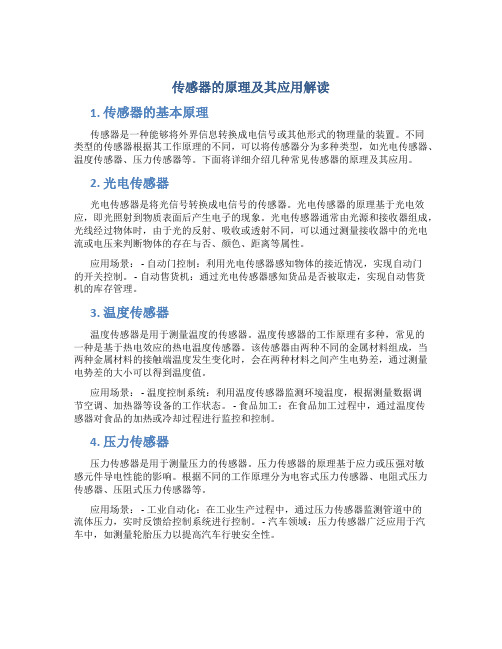
传感器的原理及其应用解读1. 传感器的基本原理传感器是一种能够将外界信息转换成电信号或其他形式的物理量的装置。
不同类型的传感器根据其工作原理的不同,可以将传感器分为多种类型,如光电传感器、温度传感器、压力传感器等。
下面将详细介绍几种常见传感器的原理及其应用。
2. 光电传感器光电传感器是将光信号转换成电信号的传感器。
光电传感器的原理基于光电效应,即光照射到物质表面后产生电子的现象。
光电传感器通常由光源和接收器组成,光线经过物体时,由于光的反射、吸收或透射不同,可以通过测量接收器中的光电流或电压来判断物体的存在与否、颜色、距离等属性。
应用场景: - 自动门控制:利用光电传感器感知物体的接近情况,实现自动门的开关控制。
- 自动售货机:通过光电传感器感知货品是否被取走,实现自动售货机的库存管理。
3. 温度传感器温度传感器是用于测量温度的传感器。
温度传感器的工作原理有多种,常见的一种是基于热电效应的热电温度传感器。
该传感器由两种不同的金属材料组成,当两种金属材料的接触端温度发生变化时,会在两种材料之间产生电势差,通过测量电势差的大小可以得到温度值。
应用场景: - 温度控制系统:利用温度传感器监测环境温度,根据测量数据调节空调、加热器等设备的工作状态。
- 食品加工:在食品加工过程中,通过温度传感器对食品的加热或冷却过程进行监控和控制。
4. 压力传感器压力传感器是用于测量压力的传感器。
压力传感器的原理基于应力或压强对敏感元件导电性能的影响。
根据不同的工作原理分为电容式压力传感器、电阻式压力传感器、压阻式压力传感器等。
应用场景: - 工业自动化:在工业生产过程中,通过压力传感器监测管道中的流体压力,实时反馈给控制系统进行控制。
- 汽车领域:压力传感器广泛应用于汽车中,如测量轮胎压力以提高汽车行驶安全性。
5. 湿度传感器湿度传感器是用于测量空气湿度的传感器。
湿度传感器的工作原理有电容式湿度传感器、电阻式湿度传感器等。
压力传感器的原理和应用
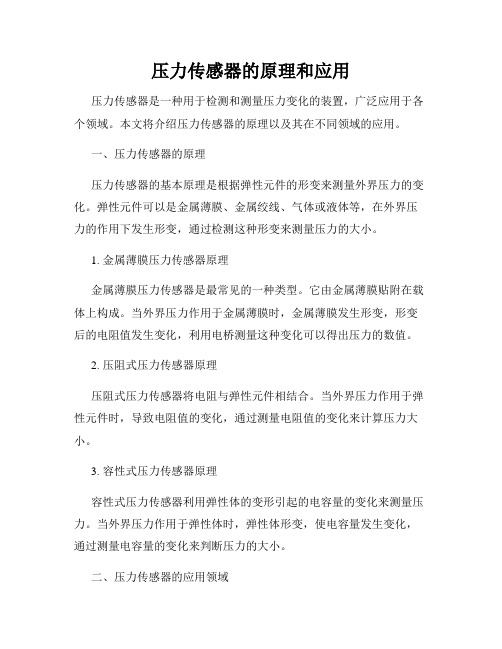
压力传感器的原理和应用压力传感器是一种用于检测和测量压力变化的装置,广泛应用于各个领域。
本文将介绍压力传感器的原理以及其在不同领域的应用。
一、压力传感器的原理压力传感器的基本原理是根据弹性元件的形变来测量外界压力的变化。
弹性元件可以是金属薄膜、金属绞线、气体或液体等,在外界压力的作用下发生形变,通过检测这种形变来测量压力的大小。
1. 金属薄膜压力传感器原理金属薄膜压力传感器是最常见的一种类型。
它由金属薄膜贴附在载体上构成。
当外界压力作用于金属薄膜时,金属薄膜发生形变,形变后的电阻值发生变化,利用电桥测量这种变化可以得出压力的数值。
2. 压阻式压力传感器原理压阻式压力传感器将电阻与弹性元件相结合。
当外界压力作用于弹性元件时,导致电阻值的变化,通过测量电阻值的变化来计算压力大小。
3. 容性式压力传感器原理容性式压力传感器利用弹性体的变形引起的电容量的变化来测量压力。
当外界压力作用于弹性体时,弹性体形变,使电容量发生变化,通过测量电容量的变化来判断压力的大小。
二、压力传感器的应用领域压力传感器在许多领域中都有广泛的应用,下面将介绍其中几个常见的应用领域。
1. 工业自动化领域在工业自动化领域,压力传感器用于监测和控制各种工艺中的气体或液体的压力变化。
例如,在制造业中,通过监测设备中的气压来确保生产过程的稳定性和安全性。
2. 汽车领域压力传感器在汽车领域中扮演着至关重要的角色。
它们用于监测发动机中的油压、冷却系统中的压力以及制动系统中的液压压力。
这些信息可以用来确保发动机的正常运行和提供安全的制动性能。
3. 医疗领域在医疗领域,压力传感器用于监测患者体内的生理参数,如血压、呼吸压力等。
它们还被应用于手术设备和人工呼吸机等医疗设备中,以监测和调节压力。
4. 环境监测领域压力传感器在环境监测领域中的应用越来越广泛。
它们被用于监测气候变化、水位高度、大气压力等参数。
这些数据对于环境保护和天气预测等方面具有重要意义。
传感器的基本原理及其应用
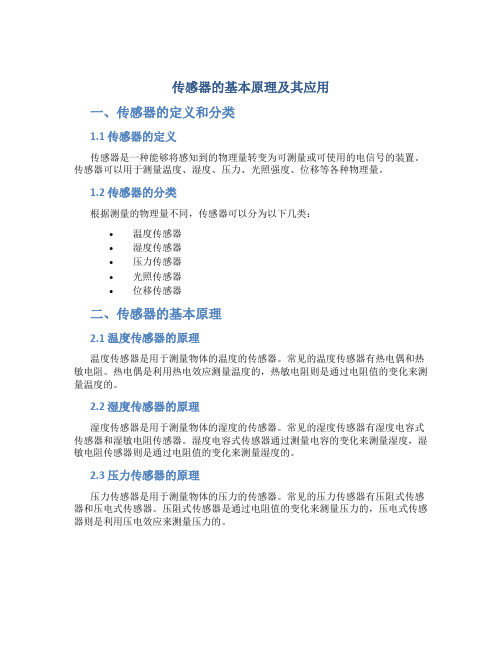
传感器的基本原理及其应用一、传感器的定义和分类1.1 传感器的定义传感器是一种能够将感知到的物理量转变为可测量或可使用的电信号的装置。
传感器可以用于测量温度、湿度、压力、光照强度、位移等各种物理量。
1.2 传感器的分类根据测量的物理量不同,传感器可以分为以下几类:•温度传感器•湿度传感器•压力传感器•光照传感器•位移传感器二、传感器的基本原理2.1 温度传感器的原理温度传感器是用于测量物体的温度的传感器。
常见的温度传感器有热电偶和热敏电阻。
热电偶是利用热电效应测量温度的,热敏电阻则是通过电阻值的变化来测量温度的。
2.2 湿度传感器的原理湿度传感器是用于测量物体的湿度的传感器。
常见的湿度传感器有湿度电容式传感器和湿敏电阻传感器。
湿度电容式传感器通过测量电容的变化来测量湿度,湿敏电阻传感器则是通过电阻值的变化来测量湿度的。
2.3 压力传感器的原理压力传感器是用于测量物体的压力的传感器。
常见的压力传感器有压阻式传感器和压电式传感器。
压阻式传感器是通过电阻值的变化来测量压力的,压电式传感器则是利用压电效应来测量压力的。
2.4 光照传感器的原理光照传感器是用于测量光照强度的传感器。
常见的光照传感器有光敏电阻和光电二极管传感器。
光敏电阻是通过电阻值的变化来测量光照强度的,光电二极管传感器则是利用光电效应来测量光照强度的。
2.5 位移传感器的原理位移传感器是用于测量物体的位移或位置的传感器。
常见的位移传感器有电感式位移传感器和光电式位移传感器。
电感式位移传感器是通过感应电磁场的变化来测量位移的,光电式位移传感器则是利用光电效应来测量位移的。
三、传感器的应用3.1 温度传感器的应用•家用电器中的恒温控制•工业生产过程中的温度监测和控制3.2 湿度传感器的应用•温室内的湿度检测和控制•空调设备中的湿度调节3.3 压力传感器的应用•工业生产中的压力监测和控制•汽车维修中对轮胎气压的检测3.4 光照传感器的应用•照明系统中的光照调节•环境监测中的光照强度检测3.5 位移传感器的应用•机械加工中的位置测量•自动化生产线中的物体定位和跟踪以上只是传感器应用的一部分,实际上,传感器在各个领域都有广泛的应用,如医疗设备、航空航天、能源管理等。
传感器原理及应用技术

传感器原理及应用技术传感器在现代科技中扮演着重要的角色,它们能够将环境中的各种物理量转化为电信号,并通过相应的技术进行采集和处理,为各种行业和领域提供了重要的数据支持。
本文将介绍传感器的基本原理以及其在不同领域的应用技术。
一、传感器的基本原理传感器是一种能够感知环境中各种物理量并将其转化为电信号的装置。
传感器的基本原理主要包括输入、转换和输出三个环节。
输入环节:传感器接收来自环境中的物理量,比如温度、压力、湿度等,并将其转化为电信号的形式。
这些物理量可以通过各种感应元件来实现,如热敏电阻、压阻、湿敏电容等。
转换环节:传感器将输入信号转化为适合采集和处理的信号形式,通常是电压信号或电流信号。
这一过程需要借助传感器内部的电路结构来实现,如放大、滤波、线性化等。
输出环节:转换后的信号被传感器输出,通常以模拟信号或数字信号的形式向外部传递。
输出信号的特性与传感器的类型和应用有关,比如模拟量输出或数字量输出。
二、传感器的应用技术传感器的应用极为广泛,涵盖了工业、农业、医疗、环保等众多领域。
下面将介绍几个典型的应用技术。
1. 温度传感器温度传感器可用于各种温度监测和控制场景。
常见的温度传感器包括热敏电阻、热电偶和热电阻等。
它们基于物质热敏性质随温度变化的原理,将温度转化为电信号输出。
在工业生产中,温度传感器广泛应用于炉温控制、室内温度监测等领域。
2. 压力传感器压力传感器用于测量各种气体和液体的压力。
根据压力的不同,常见的压力传感器有压阻式、电容式和压电式传感器。
它们利用物理量的压力与电阻、电容或电荷之间的关系,将压力转化为电信号输出。
在汽车工业中,压力传感器用于发动机燃油喷射系统的控制,提供准确的压力数据。
3. 湿度传感器湿度传感器广泛应用于气象、农业和家庭环境等领域,用于测量和控制环境的湿度。
湿度传感器的常见类型有湿敏电阻、湿敏电容和热电式湿度传感器。
它们基于介质的湿度对电阻、电容或热敏性质的影响,将湿度转化为电信号输出。
各类传感器原理及说明

各类传感器原理及说明传感器是一种用于感知环境变化并将变化转化成可测量的信号输出的设备。
它是现代智能系统中不可或缺的部分,广泛应用于各个领域,如工业控制、交通运输、医疗设备等。
本文将介绍一些常见的传感器,包括光电传感器、压力传感器、温度传感器、声音传感器和加速度传感器,并对它们的原理和应用进行说明。
1.光电传感器:光电传感器是一种利用光敏元件感知光的存在和强度的装置。
它通常由光源、接收器和信号处理电路组成。
光源发射光束,射向目标物体,当光束被反射或吸收时,接收器接收光信号并将其转化为电信号。
光电传感器可以用于检测物体的存在、位置和颜色等信息,广泛应用于自动化控制、测距仪等领域。
2.压力传感器:压力传感器是一种测量压力的装置。
它通常由传感器芯片、密封部件和信号处理电路组成。
传感器芯片可根据受力大小产生相应的电信号,信号处理电路通过放大和滤波等处理,将输出与压力成正比的电压或电流信号。
压力传感器可以用于测量气体和液体的压力情况,广泛应用于环境监测、工业控制等领域。
3.温度传感器:温度传感器是一种测量温度的装置。
常见的温度传感器有热电偶和热敏电阻等。
热电偶通过两种不同金属的连接产生温差效应,将温差转化为电信号输出;热敏电阻则是利用电阻值随温度变化的特性来测量温度。
温度传感器广泛应用于气象、医疗设备、热水器等领域。
4.声音传感器:声音传感器是一种测量声音的装置。
常见的声音传感器有麦克风和声压传感器等。
麦克风通过接收声音引起的振动,并将振动信号转化为电信号输出;声压传感器则通过测量声音引起的压力差,将压力差转化为电信号输出。
声音传感器广泛应用于通信、声音识别等领域。
5.加速度传感器:加速度传感器是一种测量物体加速度的装置。
它通常由质量块和压电传感器等组成。
当物体受到加速度作用时,质量块受力产生位移,压电传感器将位移转化为电信号输出。
加速度传感器广泛应用于汽车、航空航天、运动感应等领域。
总之,传感器是现代智能系统中必不可少的重要组成部分。
传感器原理及应用
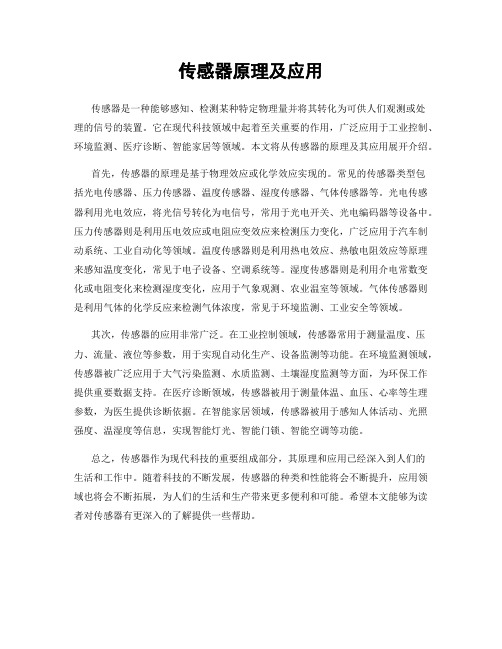
传感器原理及应用传感器是一种能够感知、检测某种特定物理量并将其转化为可供人们观测或处理的信号的装置。
它在现代科技领域中起着至关重要的作用,广泛应用于工业控制、环境监测、医疗诊断、智能家居等领域。
本文将从传感器的原理及其应用展开介绍。
首先,传感器的原理是基于物理效应或化学效应实现的。
常见的传感器类型包括光电传感器、压力传感器、温度传感器、湿度传感器、气体传感器等。
光电传感器利用光电效应,将光信号转化为电信号,常用于光电开关、光电编码器等设备中。
压力传感器则是利用压电效应或电阻应变效应来检测压力变化,广泛应用于汽车制动系统、工业自动化等领域。
温度传感器则是利用热电效应、热敏电阻效应等原理来感知温度变化,常见于电子设备、空调系统等。
湿度传感器则是利用介电常数变化或电阻变化来检测湿度变化,应用于气象观测、农业温室等领域。
气体传感器则是利用气体的化学反应来检测气体浓度,常见于环境监测、工业安全等领域。
其次,传感器的应用非常广泛。
在工业控制领域,传感器常用于测量温度、压力、流量、液位等参数,用于实现自动化生产、设备监测等功能。
在环境监测领域,传感器被广泛应用于大气污染监测、水质监测、土壤湿度监测等方面,为环保工作提供重要数据支持。
在医疗诊断领域,传感器被用于测量体温、血压、心率等生理参数,为医生提供诊断依据。
在智能家居领域,传感器被用于感知人体活动、光照强度、温湿度等信息,实现智能灯光、智能门锁、智能空调等功能。
总之,传感器作为现代科技的重要组成部分,其原理和应用已经深入到人们的生活和工作中。
随着科技的不断发展,传感器的种类和性能将会不断提升,应用领域也将会不断拓展,为人们的生活和生产带来更多便利和可能。
希望本文能够为读者对传感器有更深入的了解提供一些帮助。
传感器的主要作用及工作原理

传感器的主要作用及工作原理传感器是一种能够感知并测量外部环境信号的设备,主要用于从物理、化学、光学、电磁、声音、地质等领域中提取信息。
传感器主要作用是将外部现象转化为可量化的电信号,并通过与之连接的系统进行处理和分析。
它们在许多领域中发挥着重要作用,包括工业生产、农业、医疗保健、环境监测、安全等。
传感器的工作原理根据不同的传感器类型有所不同,下面将详细介绍一些常见的传感器及其工作原理。
1.位移传感器:位移传感器用于测量物体的位移或位置变化。
最常见的位移传感器是电阻式、电容式和感应式传感器。
电阻式传感器利用导电材料的电阻随着位移的变化而改变的特性。
电容式传感器是通过测量电容随着位移的变化而改变的原理。
感应式传感器则利用感应线圈中感应的电压或电流随着位移的变化而改变。
2.压力传感器:压力传感器用于测量气体或液体的压力变化。
常见的压力传感器有压阻式传感器和压电式传感器。
压阻式传感器通过测量导电材料的电阻随着压力的变化而改变的原理工作。
压电式传感器则是利用压电材料在加压条件下产生电荷的特性来测量。
3.温度传感器:温度传感器用于测量物体的温度变化。
常见的温度传感器有热敏电阻传感器和热电偶传感器。
热敏电阻传感器通过测量电阻随着温度的变化而改变的原理工作。
热电偶传感器是利用两种不同金属连接在一起产生温差时产生电压的特性来测量温度。
4.光传感器:光传感器用于测量光线的强度或光线的变化。
常见的光传感器有光电二极管传感器和光敏电阻传感器。
光电二极管传感器通过测量光照射到二极管上产生的电流大小来测量光线的强度。
光敏电阻传感器是利用光敏材料的电阻随着光照强度的变化而改变的原理。
5.加速度传感器:加速度传感器用于测量物体的加速度变化。
常见的加速度传感器有压电式传感器和运动传感器。
压电式传感器是通过测量压电材料在加速度作用下产生的电荷大小来测量加速度。
运动传感器则是通过测量物体的位移或速度的变化来计算加速度。
传感器的工作原理多种多样,但总体来说,它们都是将外部信号转化为电信号,并通过与之连接的系统进行处理和分析。
传感器的原理及其应用

传感器的原理及其应用1. 传感器的工作原理在科技进步的今天,传感器已经成为了我们生活和工作中不可或缺的一部分。
传感器是一种能够将各种物理量转化为可测量的电信号的设备。
传感器的原理基于物理效应或者化学反应,当外部环境的某种物理量发生变化时,传感器能够产生相应的电信号。
下面列举了几种常见的传感器及其工作原理:•温度传感器:通过测量物体或环境的温度变化来生成电信号。
常见的温度传感器包括热电阻和热电偶。
•压力传感器:通过测量物体受到的压力来生成电信号。
传感器内部通常包含弹性元件和压力敏感材料。
•光电传感器:通过感受物体与光的相互作用来生成电信号。
常见的光电传感器包括光敏电阻和光电二极管。
•湿度传感器:通过测量物体或环境的湿度变化来生成电信号。
常见的湿度传感器包括电容式传感器和电阻式传感器。
•位移传感器:通过测量物体的位移或位置来生成电信号。
常见的位移传感器包括光电编码器和压电传感器。
2. 传感器的应用领域传感器在各个领域都有着广泛的应用,以下列举了几个常见的应用领域及其对应的传感器:2.1 工业自动化•温度传感器:用于监测设备和工艺过程中的温度变化,以确保生产过程的稳定性和安全性。
•压力传感器:用于监测气体或液体的压力,以保证工业设备和管道的正常运行。
•液位传感器:用于监测储液器或液体管道中的液位,以避免时刻监测液体的容量。
2.2 智能家居•环境传感器:用于检测室内温度、湿度和空气质量等参数,以提供舒适的居住环境。
•光照传感器:用于自动调节室内灯光亮度,以节约能源并提高居住舒适度。
•雨水传感器:用于自动控制智能灌溉系统,以根据降雨情况来灌溉花园和植物。
2.3 医疗器械•心率传感器:用于监测患者的心率,以及时发现异常情况并采取相应的治疗措施。
•血氧传感器:用于测量患者的血氧饱和度,以判断呼吸和循环系统的功能状态。
•压力传感器:用于监测医疗设备中的气体或液体的压力,以确保设备正常运行。
2.4 汽车工业•车速传感器:用于获取车辆的实时速度信息,以调节发动机功率和制动力度。
传感器原理及其应用的设计

传感器原理及其应用的设计1. 介绍在现代科技的发展中,传感器起着至关重要的作用。
传感器是一种能够感知和测量某种物理量或者化学量的装置,能够将感知到的信息转化为电信号或其他形式的输出信号,用于控制和监测各种设备和系统。
本文将介绍传感器的工作原理以及其在各个领域的应用。
2. 传感器工作原理传感器的工作原理基于不同的物理原理和测量方式。
以下是一些常见的传感器工作原理:2.1 压力传感器压力传感器基于压力的改变来检测物体的压力。
它包含一个膜片或弹簧,当物体施加压力时,膜片或弹簧发生形变,进而改变电阻、电容或电感等电性能,从而测量出压力大小。
2.2 温度传感器温度传感器用于测量物体的温度。
最常见的温度传感器是基于热敏电阻或热敏电阻元件的。
温度传感器根据温度的变化改变电阻值,通过测量电阻值的变化来估计物体的温度。
2.3 光传感器光传感器用于检测物体的光照强度。
它利用光电效应或者光敏元件对光的感知来测量光的强度。
光传感器通常使用光敏二极管或者光敏电阻来测量光的强度。
2.4 加速度传感器加速度传感器用于测量物体的加速度和振动。
它采用微机电系统(MEMS)技术或压电效应来感知物体的加速度变化。
加速度传感器广泛应用于汽车安全系统、智能手机和运动监测设备等领域。
3. 传感器应用的设计传感器在各个领域都有广泛的应用。
以下是一些传感器应用的设计示例:3.1 工业控制传感器在工业控制中扮演重要的角色。
例如,压力传感器用于监测和控制工业过程中的液体和气体压力。
温度传感器用于监测工业装置的温度,以确保操作在安全和有效的范围内。
光传感器可用于检测产品的质量,例如检测产品表面的缺陷或异物。
3.2 医疗设备传感器在医疗设备中的应用非常广泛。
例如,心率传感器用于监测患者的心率变化,以便及时采取必要的措施。
血氧传感器用于测量血液中的氧气饱和度,以监测患者的呼吸和循环功能。
体温传感器用于测量患者的体温,用于诊断和治疗过程中的监测。
3.3 智能家居随着智能家居技术的发展,传感器在家用设备中的应用变得越来越普遍。
生活中传感器的应用及其原理

生活中传感器的应用及其原理1. 引言传感器作为现代科技的重要组成部分,广泛应用于各个领域,以满足人们对信息的获取和控制的需求。
本文将针对生活中常见的传感器进行介绍,包括其应用领域及工作原理。
2. 温度传感器•应用领域:–家用电器–工业自动化–汽车行业•工作原理:–常见的温度传感器有热电偶、热电阻和半导体传感器等。
–热电偶通过两种不同金属的热电势差来测量温度。
–热电阻则利用材料电阻随温度变化的特性来实现温度测量。
–半导体传感器是通过半导体材料的电阻随温度变化而变化来实现温度测量。
3. 湿度传感器•应用领域:–室内环境监测–农业领域–仓储管理•工作原理:–湿度传感器通常分为电容式、电阻式和电导式等不同类型。
–电容式湿度传感器通过测量介质的电容变化来计算湿度。
–电阻式湿度传感器则利用材料电阻随湿度变化的特性来实现湿度测量。
–电导式湿度传感器是通过测量介质的电导率来推算湿度。
4. 光照传感器•应用领域:–光照控制–智能家居–能源管理•工作原理:–光照传感器常见的类型有光敏电阻、光电二极管和图像传感器等。
–光敏电阻通过测量材料的电阻随光照变化的特性来实现光照测量。
–光电二极管通过测量光照照射到二极管上电流的变化来实现光照测量。
–图像传感器则可以通过像素上的光敏元件测量光照强度。
5. 声音传感器•应用领域:–声音检测–声音控制–安防监控•工作原理:–声音传感器常见的类型有电容式和压电式等。
–电容式传感器是通过测量变声片电容的变化来实现声音的检测。
–压电式传感器则利用材料在受到声波激励时产生电势差来实现声音的检测。
6. 运动传感器•应用领域:–运动检测–人体姿势识别–安防监控•工作原理:–运动传感器通常采用加速度计、陀螺仪和磁力计等技术来实现。
–加速度计通过测量加速度的变化来检测物体的运动状态。
–陀螺仪是通过测量物体角速度的变化来检测物体的旋转状态。
–磁力计则利用磁场感应原理来检测物体的方向和位置。
7. 总结传感器在生活中的应用越来越广泛,为我们提供了各种各样的便利和安全保障。
五种常用的传感器的原理和应用
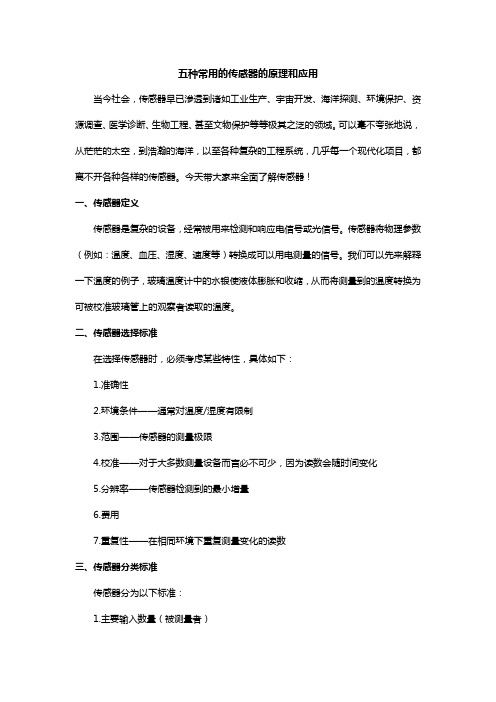
五种常用的传感器的原理和应用当今社会,传感器早已渗透到诸如工业生产、宇宙开发、海洋探测、环境保护、资源调查、医学诊断、生物工程、甚至文物保护等等极其之泛的领域。
可以毫不夸张地说,从茫茫的太空,到浩瀚的海洋,以至各种复杂的工程系统,几乎每一个现代化项目,都离不开各种各样的传感器。
今天带大家来全面了解传感器!一、传感器定义传感器是复杂的设备,经常被用来检测和响应电信号或光信号。
传感器将物理参数(例如:温度、血压、湿度、速度等)转换成可以用电测量的信号。
我们可以先来解释一下温度的例子,玻璃温度计中的水银使液体膨胀和收缩,从而将测量到的温度转换为可被校准玻璃管上的观察者读取的温度。
二、传感器选择标准在选择传感器时,必须考虑某些特性,具体如下:1.准确性2.环境条件——通常对温度/湿度有限制3.范围——传感器的测量极限4.校准——对于大多数测量设备而言必不可少,因为读数会随时间变化5.分辨率——传感器检测到的最小增量6.费用7.重复性——在相同环境下重复测量变化的读数三、传感器分类标准传感器分为以下标准:1.主要输入数量(被测量者)2.转导原理(利用物理和化学作用)3.材料与技术4.财产5.应用程序转导原理是有效方法所遵循的基本标准。
通常,材料和技术标准由开发工程小组选择。
根据属性分类如下:·温度传感器——热敏电阻、热电偶、RTD、IC等。
·压力传感器——光纤、真空、弹性液体压力计、LVDT、电子。
·流量传感器——电磁、压差、位置位移、热质量等。
·液位传感器——压差、超声波射频、雷达、热位移等。
·接近和位移传感器——LVDT、光电、电容、磁、超声波。
·生物传感器——共振镜、电化学、表面等离子体共振、光寻址电位测量。
·图像——电荷耦合器件、CMOS·气体和化学传感器——半导体、红外、电导、电化学。
·加速度传感器——陀螺仪、加速度计。
传感器工作原理

传感器工作原理传感器是一种能够感知、感应并转换物理量或化学量的设备,广泛应用于各行各业。
本文将介绍传感器的工作原理,帮助读者更好地理解传感器的运行机制。
一、传感器的基本原理传感器的工作原理基于物理或化学现象的变化,通过转换这种变化来获得相应的电信号输出。
传感器分为许多种类,如温度传感器、压力传感器、光敏传感器等,每种传感器都有其独特的原理。
1. 温度传感器温度传感器利用物体的热膨胀原理进行温度测量。
当物体受热时,温度传感器内部的材料也会随之热膨胀,从而改变其电阻、电容或电压等特性,通过检测这些特性的变化,可以确定物体的温度。
2. 压力传感器压力传感器使用压力对传感器内部材料的压缩或拉伸作用进行测量。
当外部施加压力时,传感器内部的弹性元件会发生形变,从而改变电阻、电容或电压等特性,通过测量这些特性的变化,可以确定压力的大小。
3. 光敏传感器光敏传感器利用光辐射对半导体材料电导率的影响进行测量。
当光照射在光敏传感器上时,光子与半导体材料发生相互作用,导致导电能力的改变,通过测量电阻或电流的变化,可以确定光照强度。
二、传感器的工作流程传感器的工作流程可以分为感知、转换和输出三个阶段。
1. 感知阶段传感器的感知阶段是通过感知元件来感知外部环境的变化。
感知元件对于不同的传感器而言有所不同,它可以是温度敏感材料、倾斜开关、光敏元件等。
感知元件的选择与被测量的物理量相关。
2. 转换阶段当感知元件感知到环境变化后,传感器内部会进行相应的物理或化学转换,将外部的变化转化成可测量的电信号。
转换过程中会利用一定的电路设计和工作原理,使信号的变化得以准确地转化为电信号。
3. 输出阶段传感器输出阶段是将转换后的电信号输出给后续系统进行处理或分析。
输出信号可以是电压、电流或数字信号等形式。
传感器的输出通常需要经过放大、滤波等处理,以确保输出信号的准确性和可靠性。
三、传感器的应用领域传感器广泛应用于各个领域,包括工业、农业、医疗、环境监测等。
传感器原理及其应用pdf

传感器原理及其应用pdf
传感器是一种检测装置,能感受到被测量的信息,并能将感受到的信息,按一定规律变换成为电信号或其他所需形式的信息输出,以满足信息的传输、处理、存储、显示、记录和控制等要求。
传感器的原理和应用如下:
一、原理
不同类型的传感器工作原理不同,以下是两种传感器的工作原理:
1.差动变压器式传感器的工作原理:如果输出接成反向串联,则传感器的输出电压u等于两个次级线圈的电势差。
因为两个次级线圈做得一样,因此,当铁芯在中央位置时,传感器的电压u为0;当铁芯移动时,传感器的输出电压u就随铁芯位移x成线性的增加。
如果以适当的方法测量u,就可以得到与x成比例的线性读数。
2.电阻应变片的工作原理:传感器中的电阻应变片具有金属的应变效应,即在外力作用下产生机械形变,从而使电阻值随之发生相应的变化。
二、应用
1.传感器是获取自然和生产领域中信息的主要途径与手段。
2.在现代工业生产尤其是自动化生产过程中,要用各种传感器来监视和控制生产过程中的各个参数,使设备工作在正常状态或最佳状态,并使产品达到最好的质量。
3.在基础学科研究中,传感器更具有突出的地位。
现代科学技术的发展,进入了许多新领域:例如在宏观上要观察上千光年的茫茫宇宙,微观上要观察小到fm的粒子世界,纵向上要观察长达数十万年的天体演化,短到s的瞬间反应。
传感器的存在和发展,让物体有了触觉、味觉和嗅觉等感官,让物体慢慢变得活了起来。
以上内容仅供参考,如需获取更多信息,建议查阅相关文献或咨询专业人士。
传感器的原理及应用

传感器的原理及应用
传感器是一种能够感知和测量外界物理量的装置。
传感器的原理主要有以下几种:
1. 电阻性原理:利用物体的电阻变化来测量物体的某个物理量,如温度传感器、湿度传感器等。
2. 电容性原理:根据物体的电容变化来测量物体的某个物理量,如接近传感器、压力传感器等。
3. 压阻性原理:通过物体的压阻变化来测量物体的某个物理量,如力传感器、重量传感器等。
4. 光电性原理:利用光电效应来测量物体的某个物理量,如光电传感器、颜色传感器等。
5. 声电性原理:基于声音的变化来测量物体的某个物理量,如声音传感器、声压传感器等。
6. 磁敏性原理:根据物体的磁场变化来测量物体的某个物理量,如磁传感器、磁力传感器等。
传感器的应用很广泛,包括但不限于以下几个领域:
1. 工业自动化:用于测量、控制和监测生产过程中的各种物理量,如温度、压力、流量等。
2. 环境监测:用于监测大气、水质、土壤等环境参数,如空气质量传感器、水质监测传感器等。
3. 医疗健康:用于监测人体生理参数,如心率、血压、血氧浓度等。
4. 智能家居:用于实现家居自动化和智能化,如智能灯光、智能门锁、智能家电等。
5. 交通运输:用于车载系统和交通监测中,如车速传感器、停车传感器等。
总之,传感器在各个领域中都扮演了重要角色,提供了重要的数据支持和控制功能。
传感器的原理及其应用

传感器的原理及其应用随着现代科技的快速发展,传感器成为了人们生活中不可或缺的一部分。
然而,大多数人对传感器的了解仅限于它可以感知、收集一些环境信息,但对于传感器的原理以及应用领域了解不足。
本文将介绍传感器的原理及其广泛的应用。
一、传感器的原理传感器是一种能将物理量转变为电信号的设备。
它通过收集外界的物理信息,如压力、温度、湿度等,将所收集的信息转化为电信号,进而通过电路传输和处理,最终将所得到的数据输出、分析和处理出来。
传感器的这种能力是由它内部的感受器实现的。
一个传感器通常由以下部分组成:感受器、转换器、放大器、输出器和电源。
其中,感受器是传感器的核心,它直接感受外界物理量,并将这些物理量转换成一种电信号。
而转换器则将感受器输出的电信号转换成数字信号,放大器则将数字信号放大,输出器将信号输出,电源则提供能量供应。
二、传感器的应用领域1. 工业领域:在工业领域,传感器被广泛应用于物料输送、生产自动控制、安全监测、质量检测等方面。
例如,压力传感器可用于由气压和液压驱动的机械设备,用于测量压力和防止设备发生故障。
2. 环境监测:传感器可用于环境监测,例如测量气体和液体的化学成分、测量土壤温度、湿度等。
这些数据有助于研究生态系统变化和提高环境保护。
3. 医疗领域:传感器在医疗领域的应用也越来越广泛。
例如,心脏监测装置通过心率传感器来测量心跳情况,如果有异常情况,它会自动发出警报,帮助医生及时发现问题。
4. 智能家居:随着智能家居的快速发展,传感器被广泛用于家庭安全和环境监测。
例如,烟雾探测器和煤气探测器可以检测家中是否存在火灾和煤气泄漏。
5. 运动监测:在运动监测方面,传感器也有很多应用。
例如,智能手表、智能手环等设备通常会集成一个三轴加速度传感器,用于测量运动时的步数、距离、速度等数据。
三、总结传感器已经成为现代社会中不可或缺的一部分,它的应用领域十分广泛。
为了更好地突破现有技术瓶颈,传感器技术也在快速发展。
传感器的原理和应用报告

传感器的原理和应用报告1. 介绍本报告将介绍传感器的原理和应用。
传感器是将输入信号转换为可测量或可处理的输出信号的设备。
传感器广泛应用于工业、医疗、汽车、环境等领域,对于实现自动化、监测和控制等任务至关重要。
2. 传感器的工作原理传感器的工作原理是基于物理效应或化学效应。
下面列举几种常见的传感器类型及其工作原理:•光敏传感器:利用光电效应的原理,通过光线的照射引发电荷的生成和流动,从而产生电流或电压信号。
•压力传感器:基于弹性变形原理,当受到压力作用时,传感器内的弹性元件产生形变,引起电阻、电容或电感的变化。
•温度传感器:使用热电效应、热敏电阻或热敏电容的原理,测量物体的温度,生成相应的电信号。
•加速度传感器:利用质量的惯性,测量物体受到的加速度,通过压电效应或电容变化将加速度转换为电信号。
•湿度传感器:基于物体吸附水分后介电常数的变化,将湿度转换为电信号。
3. 传感器的应用领域传感器在各个领域都有广泛的应用,下面列举一些常见的应用领域:3.1 工业自动化•温度传感器用于监测工作环境的温度,保证设备的正常运行。
•压力传感器应用于工业设备的监测和控制,如气体管道、容器等的压力监测。
•光敏传感器用于检测光线强度,控制室内和室外照明系统。
3.2 医疗领域•心率传感器用于监测患者的心率,实时监测患者的心脏健康状况。
•血压传感器测量患者的血压水平,帮助医生判断患者的健康状况。
3.3 汽车领域•距离传感器用于智能停车系统,通过测量车辆与障碍物之间的距离,提供报警和辅助驾驶功能。
•油位传感器测量油箱中的油位,提供关于油量的信息供驾驶员参考。
3.4 环境监测•气体传感器应用于环境污染监测,测量空气中的有害气体浓度。
•温湿度传感器用于室内环境监测,确保室内温度和湿度在合适的范围内。
4. 传感器的优势和挑战4.1 优势•实时性:传感器能够实时监测和响应环境变化。
•精准度:传感器能够提供精确的测量结果。
•可靠性:传感器具有高度的可靠性,能够长时间稳定运行。
- 1、下载文档前请自行甄别文档内容的完整性,平台不提供额外的编辑、内容补充、找答案等附加服务。
- 2、"仅部分预览"的文档,不可在线预览部分如存在完整性等问题,可反馈申请退款(可完整预览的文档不适用该条件!)。
- 3、如文档侵犯您的权益,请联系客服反馈,我们会尽快为您处理(人工客服工作时间:9:00-18:30)。
气敏(嗅觉)传感器
概述: 气味检测是半导体气敏传感器扩大应用的主流方向之一,最有潜力的应 用领域是食品工业和医学,还有家住环境和舒适度的调节系统等。在 开发味敏传感器方面取得的主要成就是在改进提高敏感材料的灵敏度 和选择性方面,针对气味的特征成分,使用了各种掺杂剂,以适应不 同的需要。 应用: 常见的有酒精浓度传感器。 此外,在有些场合还需要分别鉴别出混合气体中的各个成分。
文本 文本 文本
Understanding of sensor:
The sensor is a detection device, can feel the measured information, and can feel the information, according to the law must transform into electric signal or other required information in the form of output, in order to satisfy the information transmission, processing, storage, display, record and control requirements. It is the most important link for realizing automatic detection and automatic control.
触觉传感器
介绍: 将压力转换为电信号输出的传感器。通常把压力测量仪表中的电测式仪 表称为压力传感器。 应用:称重传感器、霍尔传感器。 称重传感器采用金属电阻应变片组成测量桥路,利用金属电阻丝在 张力作用下伸长变细,电阻增加的原理,即金属电阻随所受应变而变 化的效应而制成的(应变,就是尺寸的变化)。 在现代化工业生产以及自动化生产过程中,需要用到各种称重传感器来 监视和控制生产过程中的各个参数,称重传感器的功能是使设备工作 在正常状态或最佳状态,并使生产出来的产品达到最好的质量。可以 说,没有众多的优良的称重传感器,现代化生产也就失去了基础。如 此看来,称重传感器将在这个智能化生产产业中是会有美好的发展前 途。治理超重。
声敏(音)传感器
概述: 声音传感器的作用相当于一个话筒(麦克风)。它用来接收声波,显 示声音的振动图象。但不能对噪声的强度进行测量。 原理: 该传感器内置一个对声音敏感的电容式驻极体话筒。声波使话筒内的 驻极体薄膜振动,导致电容的变化,而产生与之对应变化的微小电压。 这一电压随后被转化成0-5V的电压,经过A/D转换被数据采集器接受, 并传送给计算机。 应用: 在新加坡,利用声音传感器声波来确定密闭集装箱内的材料化学组成, 以此加强港口的安全。 此外,声音传感器在汽车防盗及航空探测等方面都有涉及,声音传感器 的对声纳系统的改进也贡献不小。
Photosensitive sensor -- visual acoustic sensor -- auditory gas sensor -- smell chemical sensors -- taste pressure-sensitive, Wen Min, fluid -- tactile sensor
主要作用:
人们为了从外界获取信息,必须借助于感觉器 官。 • 而单靠人们自身的感觉器官,在研究自然现 象和规律以及生产活动中它们的功能就远远不够 了。为适应这种情况,就需要传感器。因此可以 说,传感器是人类五官的延长,又称之为电五官。
•
主要特点
• 传感器的特点包括:微型化、数字化、智能化、多功能化、系统化、 网络化,它不仅促进了传统产业的改造和更新换代,而且还可能建立 新型工业,从而成为21世纪新的经济增长点。微型化是建立在微电子 机械系统(MEMS)技术基础上的,已成功应用在硅器件上做成硅压 力传感器。
Definition.
• The national standard GB7665-87 of the sensor under the definition is: "to be provided to the feelings of measurement and according to certain rules (mathematical function rule) into the device or devices available signal, usually composed of sensitive components and conversion components".
文本
文本 文本 文本
认识传感器:
传感器(英文名称:transducer/sensor)是 一种检测装置,能感受到被测量的信息,并能将 感受到的信息,按一定规律变换成为电信号或其 他所需形式的信息输出,以满足信息的传输、处 理、存储、显示、记录和控制等要求。它是实现 自动检测和自动控制的首要环节。
定义: 国家标准GB7665-87对传感器下的定义是:“能感受 规定的被测量件并按照一定的规律(数学函数法则)转换成 可用信号的器件或装置,通常由敏感元件和转换元件组 成”。 • 中国物联网校企联盟认为,传感器的存在和发展,让 物体有了触觉、味觉和嗅觉等感官,让物体慢慢变得活了 起来。” • “传感器”在新韦式大词典中定义为:“从一个系统 接受功率,通常以另一种形式将功率送到第二个系统中的 器件”。 •
Main features:
• Including the sensor characteristics: miniaturization, digitization, intelligent, multi-functional, systematic, network, it not only promoted the transformation and renewal of traditional industrial upgrading, but also may establish a new industry, which has become a new economic growth point in twenty-first Century. Miniaturization is based on micro electro mechanical system (MEMS) based on the technology, has been successfully used to make silicon pressure sensor on silicon devices.
• Chinese networking alliance thinks, the existence and development of sensor, makes the object a sense of touch, taste and smell and other sensory, let the body slowly becomes alive." • "Sensor" in the New Webster's dictionary is defined as: "receive power from a system, usually with another kind of form will power to devices in second systems".
The main role:
• In order to obtain information from the outside world, we must resort to the sense organ.
• The people's sense organs, in the study of natural phenomena and laws and production activities, it is not enough. To adapt to this situation, we need the sensor. So we can say, the sensor is the extension of human facial features, also known as electronic features.
The classification of sensor:
Often the function and human sensor 5 sense organs compared: Photosensitive sensor -- Visual Acoustic sensor -- hearing Gas sensitive sensor -- smell Chemical sensors -- taste Pressure sensitive, Wen Min, fluid -- tactile sensor
Principle and application of sensor
张梦飞 130807141331
Sensor classification :
1, the vision sensor 2, the auditory sensor 3, olfactory sensor 4, taste sensor 5, tactile sensor 6,The sensor applications 7,The prospects of the development of the sensor
味觉传感器:
• 原理: 利用脂质高分子膜。将脂质固化在高分子上,形成仿生膜转换机构, 然后通过多路电极进行味道识别,最终利用电脑分析、评价所得到的 味道情报(膜电位变化)。传感器的输出不单纯是特定呈味物质的量, 还包括味质及味刺激的强度。 应用: 将数量庞大的呈味物质划分为咸、酸、苦、鲜、甜5种基本味道,即通过 "广域选择性"的概念来识别、评价味道。还可以判断食物的新鲜程度。
